Best CPUs for Gaming: July 2024
by Gavin Bonshor on July 17, 2024 4:00 PM EST- Posted in
- Guides
- CPUs
- AMD
- Intel
- Buyer's Guides
- Zen
- APU
- Gift Guide
- Ryzen
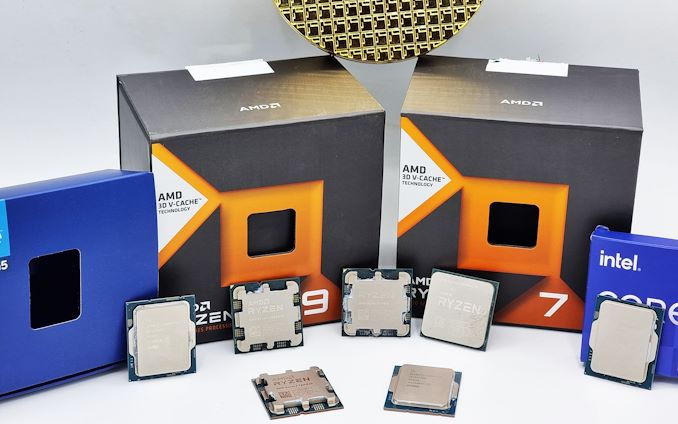
In our series of Best CPU guides, here's the latest update to our recommended Gaming CPUs list. All numbers in the text are updated to reflect pricing at the time of writing. Numbers in graphs reflect MSRP.
As the second quarter of 2024 is soon set to unfold, there are many things to be excited about, especially as Computex 2024 has been and gone. We now know that AMD's upcoming Ryzen 9000 series desktop processors using the new Zen 5 cores will be hitting shelves at the end of the month (31st July), and on top of this, AMD also recently slashed pricing on their Zen 4 (Ryzen 8000) processors. Intel still needs to follow suit with their 14th or 13th Gen Core series processors, but right now from a cost standpoint, AMD is in a much better position.
Since the publication of our last guide, the only notable CPU to be launched was Intel's special binned Core i9-14900KS, which not only pushes clock speeds up to 6.2 GHz but is the last processor to feature Intel's iconic Core I series nomenclature. The other big news in the CPU world was from Intel, with a statement issued about pushing users to use the Intel Default Specification on Intel's 14th and 13th Gen processors, which ultimately limits the performance compared to published data. We're still in the process of
While the CPU market has been relatively quiet so far this year, and things are set to pick up once AMD's Zen 5 and Intel's Arrow Lake desktop chips are all launched onto the market, it means today we are working for the same hymn sheet as our previous guide. With AMD's price drops on Ryzen 7000 series processors, much of the guide reflects this as AMD and Intel's performance is neck and neck in many use cases, but cost certainly plays a big factor in selecting a new CPU. As we move into the rest of 2024, the CPU market looks set to see the rise of the 'AI PC,' which is looking set to be something that many companies will focus on by the end of 2024, both on mobile and desktop platforms.
Best CPUs for Gaming July 2024
Sometimes, choosing a CPU can be difficult. So we've got you covered. In our CPU Guides, we give you our pick of some of the best processors available, supplying data from our reviews.
| AnandTech Gaming CPU Recommendations July 2024 (Prices as of time of writing) |
|||
| Segment | Recommendation | Amazon ($) |
Prime Day/Week |
| The High-Performance Pick | AMD Ryzen 9 7950X3D (16C/32T) | $492 | $460 |
| The Smart Money Pick (Price versus Performance) | AMD Ryzen 7 7800X3D (8C/16T) | $385 | - |
| Best Value for Gaming | AMD Ryzen 5 8600G (6C/12T) | $181 | - |
The majority of our recommendations aim to hit the performance/price curve just right, with a side nod to power consumption as well.
CPU Market Overview, July 2024: Zen 5 Is Coming In July
Before we dive into our analysis of the current CPU market, the biggest updates from our previous guide come from AMD. Not only is AMD's latest Zen 5-based Ryzen 9000 series processors expected to launch next month, but AMD has also slashed prices on their Zen 4 processors (non-G series), which potentially means the Klaxons are going off as we get closer to the launch of Zen 5. This is a typical move that not only undercuts the current pricing of Intel, making AMD chips a better proposition from a value perspective, but it clears out as much of the current stock as AMD can before Zen 5 is out.
AMD Unveils Ryzen 9000 CPUs for Desktop, Zen 5 Takes Center Stage at Computex 2024
Despite the price drops, Intel and AMD are competing well against each other in the high-end segment (in performance), with Intel's 14th Gen Core family and AMD's Ryzen 7000 and 8000 series dominating what's available in terms of flagship offerings. This isn't only good for the progression and innovation of CPU architectures and the features they add, but having two companies competing closely for the top-performance spot can be good for price, too. Still, it's good for consumers as companies have to innovate and refine processes to deliver the goods for users wanting the latest and greatest in desktop processors.
The top end of the market is still dominated by the Intel Core i9-14900K (8P+16E/32T) and AMD's Ryzen 9 7950X (16C/32T), but the Intel Core i9-14900KS adds a further and final element of spice to the Intel 14th Gen family; I say spicy because although some enjoy the flavor of spice (performance), it certainly raises temperatures to ridiculous levels. To complement this 6.2 GHz special binned CPU, a premium 360 mm AIO is recommended at the very minimum.
While the AMD Ryzen 9 7950X3D (16C/32T) is also considered a flagship chip, it is primarily aimed at gamers. It has 3D V-Cache packaging, giving gamers 96 MB of L3 V-Cache on one CCD and 32 MB on the other. Offering a more value-oriented chip with 96 MB of 3D V-Cache for gamers is the Ryzen 7 7800X3D, which has all the gaming benefits of the Ryzen 9 7950X3D but without the notoriously high price of a flagship.
Also still in the upper echelon of the CPU market is the Core i9-13900K (8P+16E/32T), which, although it hails from Intel's previous 13th Gen family, is nearly identical to the new 14900K bar a bump to core frequencies. All three processors, including this, the Core i9-14900K and the Ryzen 9 7950X, are all similarly matched in compute performance. In contrast, the only 'real' gain separating them is in AVX-512/AVX2 workloads, as AMD's Ryzen 7000 does support these instruction sets. Other than that, it's very competitive at the top.
The mid-range (Core i7/i5 and Ryzen 7/5) processors offer decent compute performance and are more than adequate for gaming when paired with a competent discrete graphics card. One major talking point is the latest Intel Core i7-14700K (8P+12E/28T), which is a marked upgrade over the previous Core i7-13700K (8P+8E/24T) and puts the 14th Gen Core i7 much closer to the i9 series than we've previously seen before. Given that the Core i7-14700K ($382) and Core i7-13700K ($330) represent Intel's mid-range segment, there's certainly some value to be found there for gamers looking for both performance and value.
When deciding which chip to use when upgrading or building a new system, users can find lots of value in Intel and AMD's previous generations (13th/12th Gen Core series and Ryzen 5000). These processors now offer unprecedented cost-effectiveness, and some of the last generation's high-performing CPUs from these previous lineups can be paired with more affordable DDR4 memory, which has come down in price massively since DDR5 was launched. Additionally, both Intel and AMD have been aggressively reducing prices as they shift their focus toward promoting their latest cutting-edge technologies and architectural advancements. While Intel's 13th Gen pricing hasn't changed much since the launch of 14th Gen, we expect these price cuts to come over the coming months as retailers look to offload their older stock.
Consequently, prospective buyers can take advantage of sporadic, continuously fluctuating, and decreasing prices. Among the noteworthy options is AMD's Ryzen 7 5800X3D, featuring 8 cores and 16 threads, along with the 3D packaged 96 MB of L3 cache. This CPU is particularly well-suited for games and applications optimized to leverage its unique 3D V-Cache in games that can support more L3 cache. With little difference in performance between Intel's 14th and 13th Gen, this makes 12th Gen an even more attractive proposition in terms of value. Let's look at where the market is going right now, and we'll make the picks that represent the best of each category as we head into the final month of Q2 2024.
The High-Performance Pick
AMD Ryzen 9 7950X3D (16-core, $492) - Stronger Gaming Performance (PRIME - $460)
Although the Intel Core i9-14900K ($549) and the more recent and faster Core i9-14900KS (basically the same performance) ultimately offer more compute performance, the Ryzen 9 7950X3D is our top choice for gaming, the Intel Core i9-13900K presents itself as a compelling alternative. With the recent price drop to $492, it not only undercuts Intel's 14th Gen i9 offerings by a slim amount going by the current retail pricing at Amazon, but in games that can make use of the 96 MB of L3 3D V-Cache, it's a no brainer to opt for AMD here.
However, the similar Ryzen 9 7950X has also dropped to $487, which is over $60 cheaper than Intel's 14th Gen Core i9 series. Still, the Ryzen 9 7950X3D stands out with its 96 MB of 3D V-Cache on the CCD, which is optimized for gaming at just a fraction of the price and is a much better choice for gamers. This configuration transforms it into an 8-core, 16-thread powerhouse with a massive 96 MB of L3 cache when gaming, especially with Microsoft Game Mode enabled and the relevant AMD drivers installed. In gaming, the Ryzen 9 7950X3D with 96 MB of L3 3D V-Cache in favorable situations is the winner here, whereas the Ryzen 9 7950X has marginally more grunt in compute performance.

As we can see in our POV-Ray benchmark results, the Intel Core i9-14900K is at the top of the pile with slightly faster clocks, and while the Core i9-13900K is the next best in the list, the AMD Ryzen 9 7950X3D was around 17% behind the Core i9-14900K which is still good. In tasks such as our V-Ray render, the Ryzen 9 7950X3D was marginally ahead of the Core i9-13900K by around 2%, and when rendering in Blender 3.3 in the long Barbershop test, the 7950X3D was ahead by about 23 seconds. Of course, both processors are more than capable of rendering and encoding, and overall, in our suite, the Core i9-13900K beats the Ryzen 7950X3D across most of our CPU test suite. However, the Ryzen 9 7950X was still competitive with the 13900K in the more compute-heavy scenarios.
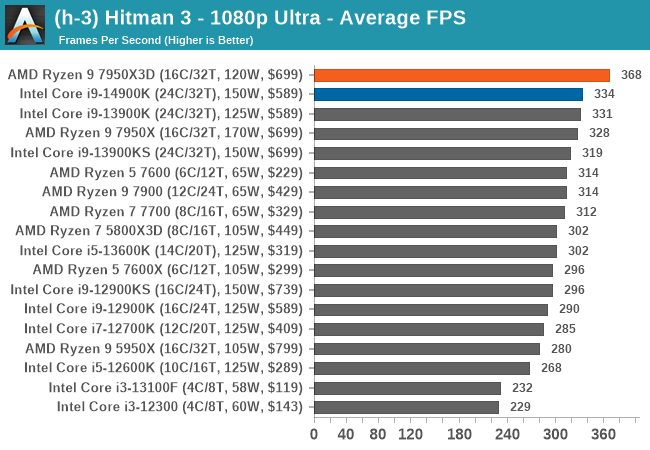
Regarding gaming performance, the AMD Ryzen 7950X3D has the advantage in titles that can leverage that additional L3 cache due to their implementation and execution of 3D V-Cache packaging. In other games that don't benefit from the large levels of L3 cache, things are much closer throughout most of the games. It's a very specific use case that AMD is capitalizing on. Still, as we've mentioned throughout much of our Ryzen X3D series coverage, if the games you play don't utilize the L3 cache, then there's not much of a real-world benefit over the competition.

Outside of the benefits mentioned above of the 3D V-Cache, things are so competitive that it boils down to the use case, the type of workload, and what programs and applications are being used. Neither AMD nor Intel's flagship offerings do much wrong in compute-heavy tasks and gaming. Still, if power draw is a concern, then AMD's highly efficient Zen 4 cores take things to another level, or, should I say, a lower level as far as total power draw goes. AMD's Ryzen 7000 series chips at full-load generate much lower wattage levels than Intel's 13th Gen Core series; the Ryzen 9 7950X3D with 16 x Zen 4 cores draws much less power than Intel's Core i5-13600K, which is a 14-core part. The Intel Core i9-14900K at maximum load drew over 428 W of power using the MSI MEG Z790 Ace Max motherboard but retesting with the ASRock Z790 Taichi Carrara motherboard; this dropped down to just below 376W; still high, but faster clocks and more power will effectively raise the power envelope.
Overall, when it comes primarily to gaming, there's much more benefit to upgrading the graphics card than focusing purely on the processor, especially at higher resolutions such as 1440p and 4K. Although there's much furor surrounding current GPU pricing and how companies such as NVIDIA are positioning their lineup, such as the latest RTX 4000 Super series, which launched earlier on in the year, it's no secret that NVIDIA's GeForce RTX 4090 is nothing short of a beast. Even AMD's Radeon RX 7900 XTX/XT caters to high resolution and those with high refresh rate monitors such as 144 Hz at a slightly lower price point, and it's unlikely that anyone will endure lower than 144 Hz frame rates with any of the mentioned options at sub 4K resolutions.
Another question to consider is, what are you upgrading from? If the answer is Ryzen 5000 or Intel's 12th Gen Core, you're more likely to notice a much bigger jump in performance by upgrading your graphics card. Of course, any of the latest and greatest chips will do the job. Even a CPU such as the Core i5-13600K ($294) will provide enough compute grunt in practically every title outside of those insane CPU-heavy games such as Microsoft Flight Simulator 2020. Even here, upgrading to a more powerful graphics card will increase frame rates more than any processor could possibly achieve. There's a reason many users are opting for CPUs from the previous generation: price cuts have made them even more attractive, and they are still competent in overall performance.
Despite this, we are opting for the AMD Ryzen 9 7950X3D ($492) as the best gaming CPU of the current generation (so far), and with 128 MB (96+32 MB) of 3D V-Cache, it really does the job in titles that can benefit from it. Even on the compute side of things, the 7950X3D has enough oomph, whereas the Ryzen 7 5800X3D, when it first launched, didn't do so well in comparison. The Intel Core i9-14900K ($549) and the Core i9-14900KS ($650) are the next best, and it's faster in more scenarios than not, but AMD has a clear advantage in power consumption and performance per watt. That being said, the Core i9-14900K, as well as the previous Core i9-13900K, can reduce the overall cost of the system by allowing use with the previous generation's Intel 600 series chipsets, as well as be paired up with cheaper DDR4 memory and still deliver high levels of multithreaded performance.
Both of these options also answer the question of future-proofing, as PCIe 5.0 SSDs have rapidly become available on the shelves. Still, in contrast, PCIe 4.0 x4 M.2 drives have been reduced, and plenty of storage bargains can be had. Still, due to the combination of both compute and gaming performance, coupled with the price, the AMD Ryzen 9 7950X3D is now even harder to beat.
Note: If you're looking to buy an AMD Ryzen 9 7950X3D chip today, Amazon has it for $460 as part of their Prime Day deals, so make sure you grab one!
The Smart Money Pick (Price versus Gaming Performance)
AMD Ryzen 7 7800X3D (8C/16T, $385)
Moving on to our smart money pick, the aim is to balance the best performance available for the best available price. It is not an easy task considering the vast number of mid-range options currently on the market, including Intel's Core 14th and 13th Gen Core i7/i5 chips and AMD's Ryzen 7/5 series. Numerous options can fulfill this criterion within AMD's Ryzen 7000 and 5000 series. For instance, the Ryzen 7 5700X boasts 8 cores and is priced at an enticing $167 making it a standout value proposition under the $200 mark. Furthermore, considering all the price drops on AMD's previous Ryzen 5000 series, it's worth noting that the Ryzen 7 5800X3D, now available at $317, is a very solid proposition for gamers on a budget.
The AMD Ryzen 7 7800X3D Review: A Simpler Slice of V-Cache For Gaming
Even though the Ryzen 7 7800X3D benefits from the latest Zen 4 cores, the makeup of the system has a higher cost overall with the combination of more expensive AM5 motherboards and a reliance on the higher-cost DDR5 memory. One reason why users may want to look at the Ryzen 7 5800X3D even though we've omitted it completely, on a strict budget and in the current economic climate, the added premiums of an AM5 motherboard and DDR5 (compared to AM4 and DDR4), the system's total price can quickly expand. That's where AM4 and the Ryzen 7 5800X3D can offer a low-cost alternative, albeit with an older CPU architecture (Zen 3 vs Zen 4), which does mean slightly lower all-around performance, but the Ryzen 7 7800X3D is the overall better choice.
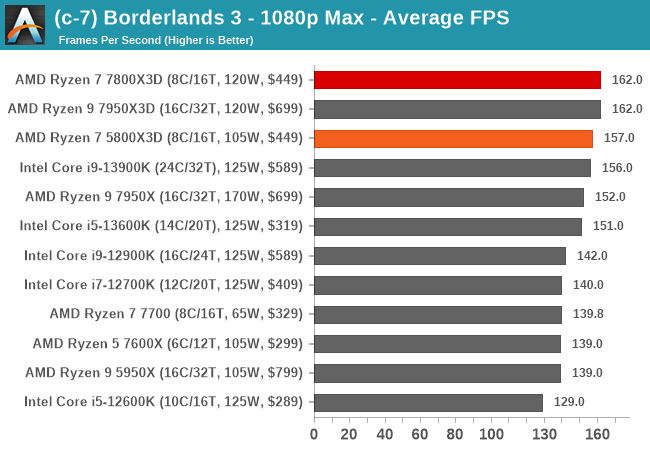
The benefits of the additional L3 cache are not especially consistent from game to game – among other things, you need to be CPU-limited to begin with to really enjoy them. Still, coupled with a cheap AM4 board and DDR4 memory, the Ryzen 7 5800X3D still warrants a look for buyers who aren't focused on gaming performance. Using Borderlands 3 at 1080p maximum settings as an example where the L3 cache does benefit performance, there's not too much difference between the flagship Ryzen 9 7950X3D ($492) and the Ryzen 7 7800X3D ($385). This is much the case in most titles that can benefit from the large levels of L3 cache, which is made possible through AMD and TSMC's 3D V-Cache packaging technology. In games that don't use the L3 cache, the beefier and gruntier CPUs take the edge, especially when not primarily CPU-limited.
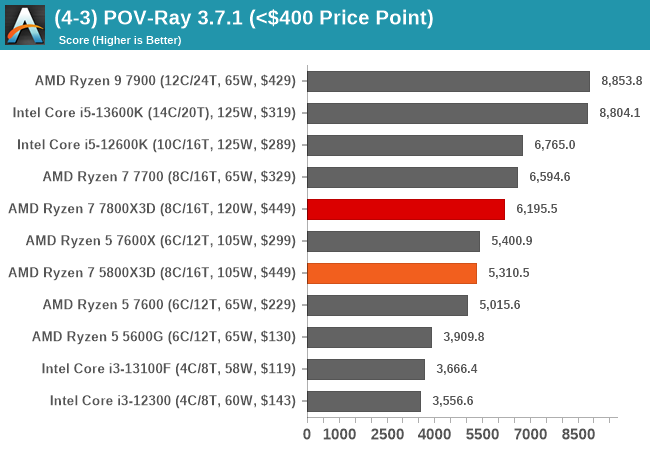
Other similarly priced CPUs shine in compute-focused scenarios, such as the Intel Core i5-13600K ($318). Still, the Ryzen 7 5800X3D ($298) holds its own, and while there are trade-offs in balancing compute and gaming performance, the Ryzen 7 5800X3D in various games certainly makes it a very worthwhile offering. Even the Ryzen 7 7800X3D at $385 isn't too far ahead of the Ryzen 7 5800X3D in compute performance, which is why the cost savings associated with opting for Zen 3, AM4, and DDR4 make it all that much sweeter and easier on the pocket.
Touching more on the associated cost savings with opting for the Ryzen 7 5800X3D, it works with the AM4 platform and can be combined with a good set of DDR4 memory for optimal performance. Paired up with a relatively cheap B550 motherboard, which is much cheaper than current AM5 motherboards, leaves some extra spending money to pick up a better discrete video card, which, although cheaper than it used to be (thankfully), they are still not especially cheap. There's also the benefit of having eight Zen 3 cores to consider, as it means multi-platform games coming from the consoles (which use eight-core Zen 2 CPUs) won't find themselves for want of a CPU core.
Even in games and scenarios that favor faster cores, the Ryzen 7 5800X3D is still competitive, and the onus is more on the graphics card than the processor, essentially meaning that the money saved on the 5800X3D over the AMD/Intel flagships can be spent on a better graphics card that will push framerates even higher. The Ryzen 7 7800X3D ($385) wins out in all situations, but the added cost makes it a case of, if you have the extra money, go for this. If on a budget, the Ryzen 7 5800X3D ($298) is more affordable overall and is still very capable.
It's worth noting that the Ryzen 7 7800X3D and Ryzen 7 5800X3D both require a discrete graphics card to be effective. The previous generation of CPUs, such as Ryzen 5000 and Intel's 13th Gen, are cheaper due to the launch of the newer counterparts last year, and even the newer chips are actually slightly cheaper than last year. With the ever-increasing demand for specifications from game developers making titles on the latest game engines and with poorly optimized console ports, it's getting harder to recommend gaming on an integrated GPU. Even though GPU prices remain at a premium price compared to yesteryear, even in the mid-range, they aren't as bad as they were during the mining craze, and there are still some bargains to be had if users are willing to look around.
The Best Overall Value Pick For Gaming
AMD Ryzen 5 8600G (6C/12T, $181)
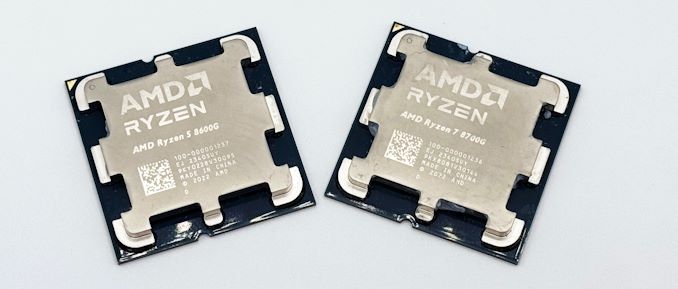
AMD Ryzen 5 8600G (left) and Ryzen 7 8700G (right) Zen 4 APUs
Our final pick is designed to reflect the best value that can be sought after when it comes to gaming performance, and while there's the debate of a low-end discrete graphics card + a CPU such as a Core i3-14100 ($130) vs one of AMD's APUs, we've elected to pick the latter. AMD recently launched the Ryzen 8000G series of APUs to the market, including the Ryzen 7 8700G (8C/16T) and Ryzen 5 8600G (6C/12T). The one that stands out to us is the Ryzen 5 8600G, which is currently available at Amazon for $181.
AMD Ryzen 7 8700G and Ryzen 5 8600G Review: Zen 4 APUs with RDNA3 Graphics
Perhaps the most important for gamers operating on a tighter budget than our other picks, which places gaming at the forefront while maintaining a value-orientated approach to balancing performance and affordability, the AMD Ryzen 5 8600G at $181 combines the performance and efficiency of AMD's Zen 4+ mobile CPU architecture with the latest mobile RDNA3 based integrated graphics. Although based on a mobile platform, which is designed for a more power-constrained environment, the Accelerated Processing Unit (APU) has long been based on this kind of design, and as we've seen through previous iterations such as the AMD Ryzen 7 5700G (8C/16T), we know there's plenty of value to be had by opting for an APU.
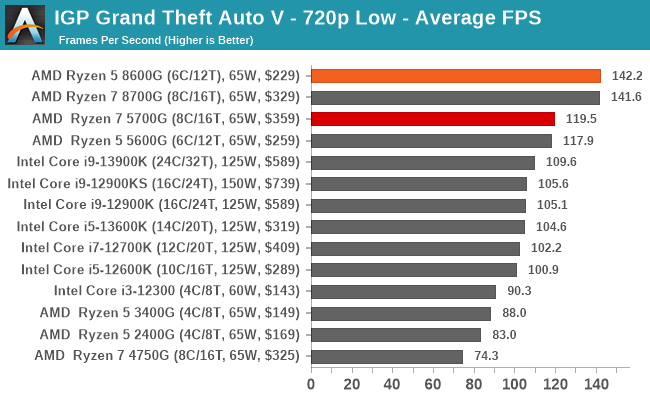
With gaming performance on a budget being the primary reason for selecting the Ryzen 5 8600G ($181), as we can see in the above chart, the previous king of the budget APUs, the Ryzen 7 5700G with Zen 3 and Radeon Vega graphics has now finally met its match. In Grand Theft Auto V, which is still ever popular, shows that the Ryzen 5 8600G with Zen 4+ and RDNA3 graphics comfortably beats the Ryzen 7 5700G ($165) by around 15%, which is an impressive uplift in performance. It's similar to other games at 720p, where the newer Ryzen 5 8600G comfortably and consistently beats out the previous Zen 3-based APUs with relative ease. Even at 1080p, where things are a little more intensive, the Ryzen 5 8600G again reigns supreme due to the powerful RDNA3 mobile graphics.
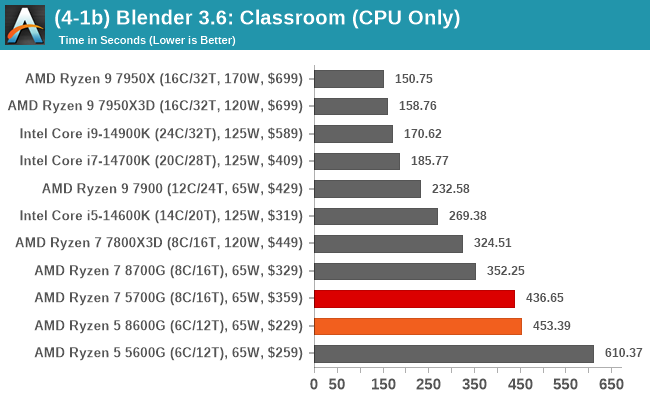
Things are much closer in compute-related situations, such as in Blender 3.6 with the Classroom test, with the Ryzen 5 8600G and Ryzen 7 5700G trading blows, despite the 5700G having 2C/4T more than the latest Zen 4+ based APU. If users want solid value performance, including solid compute and gaming performance, the Ryzen 7 8700G ($299) has a higher price but has 8C/16T of Zen 4+ and RNDA3 combined. Given that our primary focus here is on value, the Ryzen 5 8600G hits a better sweet spot at $181 for us to be palatable, given the extra costs associated with Zen 4.
Touching more on the differences between what's required for Zen 4, AMD's AM5 platform is a DDR5-only platform, and as such, it does mean that it costs a little more to adopt than the previous AM4 platform, which uses DDR4 memory. An argument could be made that the Ryzen 7 5700G, which currently costs $170 at Amazon, paired with a cheaper AM4 motherboard and DDR4 memory, could offer more in terms of value as the overall cost will be lower.
We've moved more towards the newer Ryzen 5 8600G because gaming performance, especially on the integrated graphics, is a much better proposition overall. Factoring in an AM5 motherboard, such as a reasonably priced B650 model coupled with DDR5 memory, simply makes more sense as the integrated graphics cannot be upgraded, and users wanting more gaming performance than the Ryzen 7 5700G can offer means a discrete graphics option will be needed.
At $181 from Amazon, what the Ryzen 5 8600G lacks in pure multi-threaded grunt, it certainly makes up for in 720p and 1080p gaming performance. Comparing it to a lower-end discrete graphics card plus a reasonably priced desktop processor will ultimately cost more, and that's where something like an APU such as the Ryzen 5 8600G ultimately shines.
In the broader context of everything gaming, game consoles offer some of the best value when considering a true budget solution. There's also another emerging market to consider: the gaming handhelds, including the Steam Deck, the ASUS ROG Ally, and the MSI Claw A1M. While these aren't desktop replacements, they don't offer as much flexibility with what can be done or come even close to the full potential of the PC for gaming; they certainly do make their mark on the portable side, though. Factoring in Xbox Game Pass and other subscription-based services such as EA Play (also on PC) and game consoles offer the best levels of value overall, even if they are limited in design and capability.



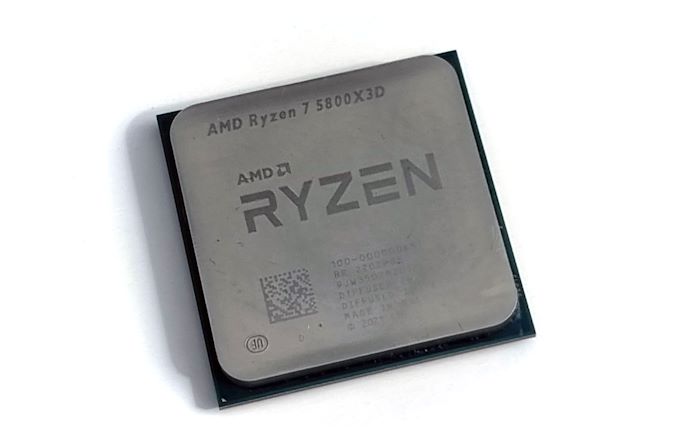








11 Comments
View All Comments